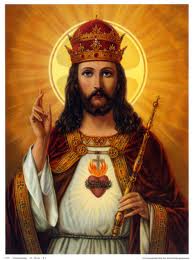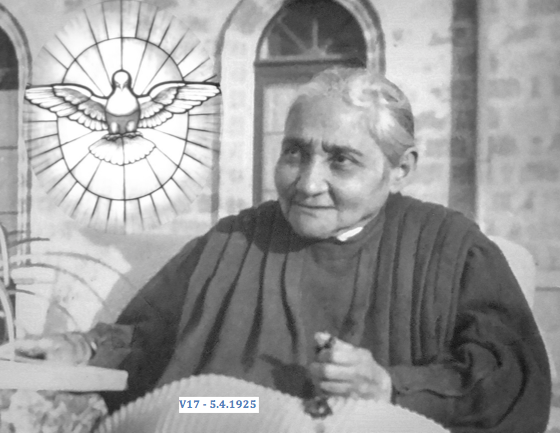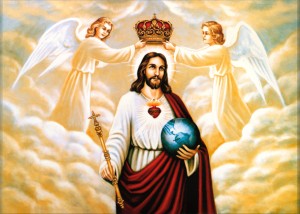For brief readings on Christ the King go to here.
And find the full booklet here.
For brief readings on Christ the King go to here.
And find the full booklet here.
Feast of Christ The King

By the Servant of God Luisa Piccarreta
The Little Daughter of the Divine Will
Novena to Christ the King
November 16 – 24, 2018
Day 1 – November 16
V5 – 10.12.03 – “…the Crown of Thorns means that there is no glory and honor without thorns; that there can never be dominion over passions and acquisition of Virtues without feeling oneself being pricked deep in one’s flesh and spirit, and that True Reigning is in mastering oneself by the pricks of mortification and of sacrifice.
Moreover, these thorns signified that I AM the True and Only King, and only one who Constitutes Me King of her heart enjoys Peace and Happiness, and I Constitute her queen of My Own Kingdom. So, all those rivulets of Blood which poured from My Head were many little streams which bound the human intelligence to the Knowledge of My Sovereignty over them.”
Prayer: My Sweet Jesus,…You are waiting for them (creatures) to call You into their midst, to receive You as Triumphant King, and to make You Reign on earth as in Heaven. Linked with Luisa we pray, “Let Your Kingdom Come. O please, let It be Known, Loved and Possessed by the human generations.”
Day 2 – November 17
V6 – 4.16.05 – “Today is the Day of the Palms in which I was Proclaimed King. All Must aspire to a kingdom, but in order to acquire the Eternal Kingdom it is Necessary for the creature to acquire the regime of herself through the dominion of her passions. The only means is Suffering, because Suffering is Reigning; that is, through Patience, man puts himself in his place, becoming king of himself and of the Eternal Kingdom.”
Prayer: My Sweet Jesus,…You are waiting for them (creatures) to call You into their midst, to receive You as Triumphant King, and to make You Reign on earth as in Heaven. Linked with Luisa we pray, “Let Your Kingdom Come. O please, let It be Known, Loved and Possessed by the human generations.”
Day 3 – November 18
V11 – 5.18.15 – “Just as the kings of the earth have their own courts and quarters in which they keep safe in the midst of dangers and among the fiercest enemies – since their strength is such that while the enemies destroy other places, they do not dare to look at that point for fear of being defeated – in the same Way, I too, King of Heaven, have My Quarters and My Courts on earth. These are the souls who Live in My Volition, in whom I Live; and the Court of Heaven crowds round them.”
Prayer: My Sweet Jesus,…You are waiting for them (creatures) to call You into their midst, to receive You as Triumphant King, and to make You Reign on earth as in Heaven. Linked with Luisa we pray, “Let Your Kingdom Come. O please, let It be Known, Loved and Possessed by the human generations.”
Day 4 – November 19
V13 – 9.2.21 – “You Must Know that I Acted with you, Luisa, as a King who begins to Love a friend, who is very dissimilar from Him in status; but His Love is so Great, that He has decided to make him similar to Himself. Now, this King cannot do everything at once and render His friend like Himself; rather, He does it little by little. First He prepares a Royal Palace for him, similar to His own; then He sends the Adornments to decorate the Royal Palace. He forms a little Army for him; then He gives him half of His Kingdom, so as to be able to say: ‘What you possess, I possess. King am I – king are you’. However, each time the King would give him His Gifts, He would look at his faithfulness; and giving the Gift would be for Him an occasion for New Contentment, Greater Glory and Honor for Himself, and a New Feast.”
Prayer: My Sweet Jesus,…You are waiting for them (creatures) to call You into their midst, to receive You as Triumphant King, and to make You Reign on earth as in Heaven. Linked with Luisa we pray, “Let Your Kingdom Come. O please, let It be Known, Loved and Possessed by the human generations.”
Day 5 – November 20
V13 – 11.19.21 – “…This is why I Love so much one who Lives in My Will: I Recognize My Portrait in her, My Noble Features; I feel My Own Breath, My Voice; and if I did not Love her I would defraud Myself. I would be like a father without offspring, without the noble cortege of his court, and without the crown of his children. And if I did not have the offspring, the court and the crown, how could I call Myself a King? My Kingdom is formed by those who Live in My Will, and from this Kingdom, I choose the Mother, the Queen, the children, the ministers, the army, the people. I AM everything for them, and they are all for Me.”
Prayer: My Sweet Jesus,…You are waiting for them (creatures) to call You into their midst, to receive You as Triumphant King, and to make You Reign on earth as in Heaven. Linked with Luisa we pray, “Let Your Kingdom Come. O please, let It be Known, Loved and Possessed by the human generations.”
Day 6 – November 21
V15 – 7.25.23 – “…wanting to scrutinize Me also, Pilate asked Me: “Are You king? And where is your kingdom?” I wanted to give another sublime lesson by saying: “I AM King”. And I wanted to say: “But do you know what My Kingdom is? My Kingdom is My Pains, My Blood, My Virtues. This is the True Kingdom which I Possess, not outside of Me, but Within Me. What one possesses on the outside is not a true kingdom, nor a safe dominion, because that which is not inside of man can be taken away, usurped, and he will be forced to leave it. But that which he has inside, no one will be able to take away from him – its dominion will be Eternal within him. The Characteristics of My Kingdom are My Wounds, the Thorns, the Cross. I do not act like the other kings who make their peoples live outside of them, unsafe, and eventually, even starving. Not Me – I Call My peoples to dwell inside the Rooms of My Wounds, fortified and sheltered by My Pains, their thirst quenched by My Blood, their hunger satisfied by My Flesh. This alone is True Reigning; all other reigns are reigns of slavery, of dangers and of death, while in My Reign there is True life.”
“This is the Kingdom of Peace, to which all My children should aspire.”
Prayer: My Sweet Jesus,…You are waiting for them (creatures) to call You into their midst, to receive You as Triumphant King, and to make You Reign on earth as in Heaven. Linked with Luisa we pray, “Let Your Kingdom Come. O please, let It be Known, Loved and Possessed by the human generations.”
Day 7 – November 22
V13 – 12.3.21 – “…Since this thing is Great – Establishing My Kingdom in the soul also on earth – I Acted like a king who has to take possession of a kingdom. He does not go there first; rather, first he has his royal palace prepared; then he sends his soldiers to prepare the Kingdom and to dispose the peoples to his subjection; then follow the guards of honor and the ministers – and the last one is the King. This is decorous for a King. So I did: I had My Royal Palace prepared, which is the Church; the soldiers have been the Saints, in order to make Me known to the peoples; then came the Saints who sowed miracles, as My most intimate ministers; and now I Myself Come to Reign as the King. Therefore, I had to choose a soul, Luisa, in whom to Establish My first Dwelling, and in whom to found this Kingdom of My Will. So, let Me Reign, and give Me full Freedom.”
Prayer: My Sweet Jesus,…You are waiting for them (creatures) to call You into their midst, to receive You as Triumphant King, and to make You Reign on earth as in Heaven. Linked with Luisa we pray, “Let Your Kingdom Come. O please, let It be Known, Loved and Possessed by the human generations.”
DAY 8 – November 23
V36 – 5.10.38 – “…I Burn of Love. I feel like Fainting, I AM Delirious for Desire of Love. And to reach this end, do you know what I do? I put My Love in the heart of the creature, I let it flow in her mind, words, works and steps; I turn all this Love that Flows everywhere into coins of Divine Love, and to let it circulate as Our Currency We impress on them My Image and the Writing: ‘Jesus, King of the Kingdom of the Divine Will.’
Prayer: My Sweet Jesus,…You are waiting for them (creatures) to call You into their midst, to receive You as Triumphant King, and to make You Reign on earth as in Heaven. Linked with Luisa we pray, “Let Your Kingdom Come. O please, let It be Known, Loved and Possessed by the human generations.”
DAY 9 – November 24
V36 – 5.6.38 – “I would never have Come down from Heaven without the Court of My People; without a Reign in which I could Dominate with My Laws of Love. All the centuries are just like a point for us, in which everything is Ours, in Action. Therefore, when I Came down from Heaven as Dominator and King of My children, I felt courted and Loved—as only We can do—and My Love was such that My children were all conceived together with Me. I just couldn’t be without them; I couldn’t have tolerated not finding My Loving children. So they grew with Me in the Womb of My Queen Mother; they were born together with Me, cried with Me, did everything I did. They walked, worked, prayed and suffered together with Me, and I can say that they were with me even on My Cross, to die and Rise Again to New Life for human generations.
“Therefore, the Kingdom of Our Will is already Established. We know its numbers, we know them all by name. We already feel them palpitating in Ardent Love.
Prayer: My Sweet Jesus,…You are waiting for them (creatures) to call You into their midst, to receive You as Triumphant King, and to make You Reign on earth as in Heaven. Linked with Luisa we pray, “Let Your Kingdom Come. O please, let It be Known, Loved and Possessed by the human generations.”
FEAST OF CHRIST THE KING – November 25, 2018
CONSECRATION TO JESUS CHRIST
KING OF THE UNIVERSE
“Oh Jesus, King of kings, God of Goodness, God of Love, God of Mercy, I adore, I love, I thank, I
glorify Your Most Holy Will emanating from Your Omnipotence, guided by Your Wisdom, accompanied by Your Goodness and Love.
Everywhere and in every time, be it either in joy or in pain, may Your Most Holy Will, Your Divine Love, be the star that I gaze at, the law that governs me, the air that I breathe, the heartbeat of my heart, the substance or, better, the Life of my life. To such an end, I unite all my prayers and actions to Yours, all my life to Yours, as well as to that of the Virgin Mother, of Saint Joseph and of all the Elect that have been, are now and shall ever be, with all good, past, present and future which is real and possible in Heaven and on earth.
I consecrate and give all myself, what I have, what I am, what pertains to me, what is dear to me, my life, my death, my eternity, all that You have created and will create by Your Supreme Volition, by Your Infinite Love. And I pray You, oh Infinite Wisdom, to inscribe me with indelible characters in Your adorable Heart as the ardent and zealous child of Your Divine Volition, of Your pure Love. I make this donation in the Power of the Father, in the Wisdom of the Son, in the Virtue of the Holy Spirit, in my name, and in the name of all creatures to obtain the advent and the expansion of the Kingdom of the Divine Will, of Your Divine Love upon the earth. For pity’s sake, oh my Lord, grant that from every lip and from every heart there may continually be raised, as from a sacred altar, the prayer that You, Yourself, as the first, addressed to the Father, “YOUR KINGDOM COME! YOUR WILL BE DONE ON EARTH AS IT IS IN HEAVEN.”
Fiat! Amen!
Command Prayer
Abba Father,
In the Name of Jesus,
In the Unity, Power and Love of the Holy Spirit,
Under the Mantle of Mary,
with all the Angels and Saints,
through the Intercession of The Servant of God Luisa Piccarreta,
Repeat the Greatest Miracle Your Omnipotence can Perform, let us be one with Luisa and live in Your Fiat,
that You may see Your Image in us, Intact, Beautiful, just as You Delivered it from Your Paternal Womb.
May we do nothing but take and give to You Continuously as Your True Children.
Please take our humble prayer, surrendered to You, O Lord,
and make it Your Command.
With the Crown of King on Your Head and with the Scepter of Command in Your Hand,
let us be one with Luisa, the One who Lives In Your Will;
May You Recognize her in us, so that You may be Everything for us, and we may be All for You.
Please take our humble prayer, surrendered to You, O Lord,
and make it Your Command.
May Your Church give You All the Honors that Befit You,
and may She honor and institute the Feast of the Kingdom of Your Divine Will.
May we be Your True people who will hasten to make known Luisa and the Divine Will,
and may the Divine Will Reign, making us a people worthy of Such a King.
Please take our humble prayer, surrendered to You, O Lord,
and make it Your Command.
As Luisa Received the Right to Possess within her soul the Kingdom of the Divine Will,
as well as the Right to Take in Hand the Scepter of Command with Absolute Dominion,
may we bind our love in all the Divine Acts, returning to You the Right of Justice
that Your Will Demands, and with these Links of Connection of all Divine acts,
You may Give us the Right that the Divine Will Reign in us, Your children.
May this be the Reality of what You have Decreed, Almighty, Triune God.
Please take our humble prayer, surrendered to You, O Lord,
and make it Your Command.
May You Pour Out Your Infinite Mercy upon all souls, past, present and future,
so that all may be Sanctified, Divinized, and give You, as all owe You, the Right of Justice.
May this be the beginning of the Coming of Your Kingdom upon earth,
and the Final Fulfillment of Your Will.
May all be accomplished and completed in Your Most Holy Divine Will.
Fiat! Amen!

